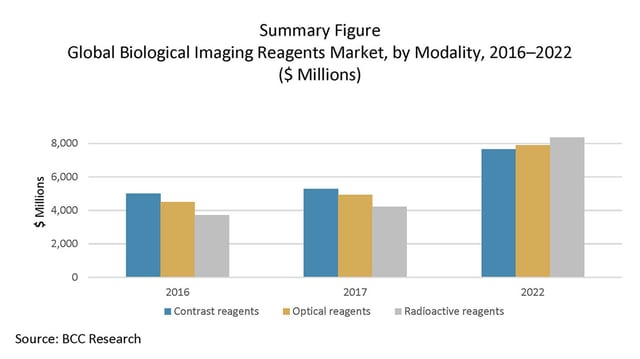
Oct 20, 2017
Blog Life Sciences Biomarker Advances Push Rapid Growth in Biologic Imaging Reagents
Biologic imaging reagents play a fundamental role in today’s medical, pharmaceutical and biotechnology industries. Such reagents are integral to the diagnostics industry, which is the largest market for these products. Driven primarily by advancements in biomarker technology in medical diagnostics, the global market for biologic imaging reagents has the potential to reach $23.9 billion by 2022. In a new study by BCC Research, the industry’s prospects are examined by the main reagent classes: contrast, nuclear (radioactive) and optical.
Optical imaging reagents allow life sciences researchers and drug developers to visualize and detect biological processes at the molecular level and to perform key genomics, proteomics and cellular analysis assays. Nuclear and contrast reagents provide important diagnostic information to physicians, enabling the early detection and treatment of diseases in the areas of cardiology, neurology and oncology. From less than $15 billion in 2017 sales, the global biologic imaging market is expected to achieve double-digit growth through 2022.
BCC Research Highlights
Upcoming BCC Research Event: Companion Diagnostics & Personalized Medicine
“Biomarkers hold tremendous potential to have a positive impact on the success rates of clinical trials, drug development and medical diagnosis,” said Robert G. Hunter, BCC Research senior editor, healthcare. “Selective, targeted imaging reagents show promise for new medical diagnostic applications, including the early detection of Alzheimer’s disease and cancers.”
Global Biologic Imaging Reagents Market by Modality, 2016–2022

Contrast reagents include those used in magnetic resonance imaging, ultrasound and x-ray/computed tomography. Nuclear reagents encompass imaging radiopharmaceuticals. Optical reagents consist of fluorescent dyes and probes, gold nanoparticles, quantum dots and fluorescent proteins. Nanoparticles are small particles, with one or more dimensions of 100 nanometers or less, that are used in biotechnology applications such as drug delivery systems or imaging agents. Nanoparticles are larger than fluorescent dyes, which have an average size of less than 0.5 nanometer. Nanoparticles are used in small animal in vivo imaging and in vitro diagnostics.
Use of Gold Nanoparticles to Assess Diseases
A nanoprobe is a type of optical device that produces an image based on the Raman scattering effect of light. The reflected light demonstrates vibration energies that are unique to each object, allowing them to be characterized and identified. Nanoprobes that have been developed at the University of Birmingham can be used to track blood flow within the smallest blood vessels in the body (the microvasculature). This information can help with the earlier diagnosis of conditions such as thrombosis and vascular inflammation. Because of their small size, nanoprobes do not disturb the blood flow.
The new method, devised by Professor Zoe Pikramenou, involves the use of iridium-coated gold nanoparticles. These act as luminescent probes for optical imaging in blood. As detailed in the magazine Controlled Environments, the researcher has said that the key lies in both the small size of the nanoparticles and the characteristic luminescent properties: “The iridium gives a luminescent signal in the visible spectrum, providing an optical window which can be detected in blood. It is also long-lived compared to organic fluorophores, while the tiny gold particles are shown to be ideal for tracking flow and [can] be detected clearly in tissues.”
Trials have shown how the nanoprobes enter blood circulation and are able to be imaged by fluorescence in different organs. In addition to imaging, a future application could involve their use in targeted drug delivery. The research has been published in the journal Nanomedicine.
Standards Needed for Quantitative Imaging Biomarkers
Continuous developments in quantitative imaging biomarkers have created the need for standards. The images acquired are not uniform, and there can be differences in interpretation at different levels. Image-based assessment of treatment responses can be highly variable, depending on the make and model of the imaging equipment used; how the images were acquired and processed; and the guidelines used for interpretation. For more research and market forecasts, download the report overview for Biologic and Medical Imaging Reagents: Global Markets (HLC040E).
In today’s fast-paced biomedical world, researchers and pharmaceutical companies...

Radiopharmaceuticals represent a cutting-edge frontier in modern medicine, offer...

Implantable Remote Patient Monitoring (IRPM) devices are revolutionizing healthc...

We are your trusted research partner, providing actionable insights and custom consulting across life sciences, advanced materials, and technology. Allow BCC Research to nurture your smartest business decisions today, tomorrow, and beyond.
Contact UsBCC Research provides objective, unbiased measurement and assessment of market opportunities with detailed market research reports. Our experienced industry analysts assess growth opportunities, market sizing, technologies, applications, supply chains and companies with the singular goal of helping you make informed business decisions, free of noise and hype.